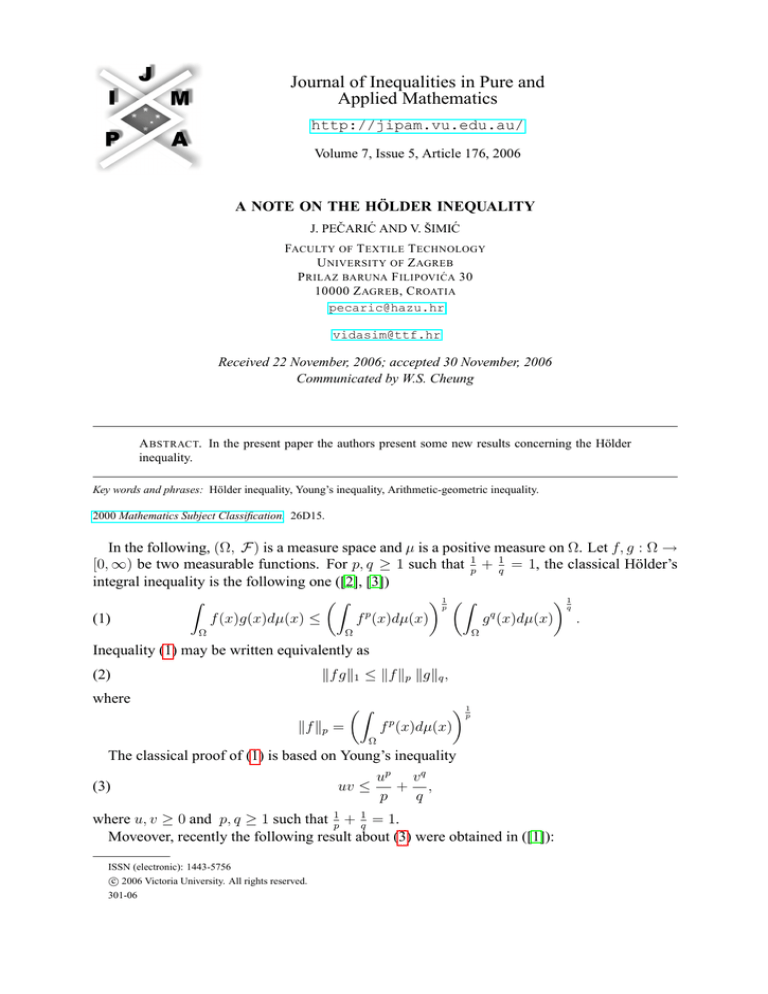
Journal of Inequalities in Pure and
Applied Mathematics
http://jipam.vu.edu.au/
Volume 7, Issue 5, Article 176, 2006
A NOTE ON THE HÖLDER INEQUALITY
J. PEČARIĆ AND V. ŠIMIĆ
FACULTY OF T EXTILE T ECHNOLOGY
U NIVERSITY OF Z AGREB
P RILAZ BARUNA F ILIPOVI ĆA 30
10000 Z AGREB , C ROATIA
pecaric@hazu.hr
vidasim@ttf.hr
Received 22 November, 2006; accepted 30 November, 2006
Communicated by W.S. Cheung
A BSTRACT. In the present paper the authors present some new results concerning the Hölder
inequality.
Key words and phrases: Hölder inequality, Young’s inequality, Arithmetic-geometric inequality.
2000 Mathematics Subject Classification. 26D15.
In the following, (Ω, F) is a measure space and µ is a positive measure on Ω. Let f, g : Ω →
[0, ∞) be two measurable functions. For p, q ≥ 1 such that p1 + 1q = 1, the classical Hölder’s
integral inequality is the following one ([2], [3])
1q
Z
p1 Z
Z
p
q
g (x)dµ(x) .
(1)
f (x)g(x)dµ(x) ≤
f (x)dµ(x)
Ω
Ω
Ω
Inequality (1) may be written equivalently as
kf gk1 ≤ kf kp kgkq ,
(2)
where
Z
kf kp =
p1
f (x)dµ(x)
p
Ω
The classical proof of (1) is based on Young’s inequality
up v q
(3)
uv ≤
+ ,
p
q
where u, v ≥ 0 and p, q ≥ 1 such that p1 + 1q = 1.
Moveover, recently the following result about (3) were obtained in ([1]):
ISSN (electronic): 1443-5756
c 2006 Victoria University. All rights reserved.
301-06
2
J. P E ČARI Ć AND V. Š IMI Ć
Lemma 1. Let u, v ≥ 0 and p, q ≥ 1 such that
1
p
+
1
q
= 1. Then for p ≥ 2
1
P (u, v) ≤ u2−p (v − up−1 )2 ,
2
(4)
where
up v q
+
− uv.
p
q
If p ∈ (1, 2], then the reverse inequality in (4) is valid. For p = 2 we have the identity in (4).
P (u, v) =
First, we shall give a new proof of Lemma 1.
Proof. Inequality (4) is equivalent to the following
1 2−p 2
1 1
vq
u v +
−
up −
≥ 0,
2
2 p
q
i.e.
u2−p
q
(5)
q 2 q(p − 2) 2(p−1)
v +
u
− v q up−2
2
2p
≥ 0.
Let us denote by Q(u, v) the left-hand side of (5). Observe that
q q(p − 2)
+
= 1.
2
2p
Suppose that p ≥ 2, that is q ≤ 2. Using the known arithmetic-geometric inequality ([2], [3])
we obtain
q(p−2)
q
q 2 q(p − 2) 2(p−1)
v +
u
≥ (v 2 ) 2 (u2(p−1) ) 2p ≡ v q up−2 .
2
2p
Thus Q(u, v) ≥ 0 and (5) is valid. For p ∈ (1, 2] applying the reverse arithmetic-geometric
inequality we have the reverse inequality in (5).
We will prove the next theorem.
Theorem 2. Suppose that p1 + 1q = 1 for 1 < q ≤ 2 ≤ p < ∞. Then the following inequalities
are valid
2 q
2−q p
q−1
g
f kgkq − g kf kp 1
1
(6)
≤ kf kp kgkq − kf gk1
q
p
2
kf kp kgkq
2 p
2−p q
p−1
f
−
f
kgk
gkf
k
p
q
1
1
.
≤
p
q
2
kf kp kgkq
Proof. If we set in (4)
(7)
u=
f (x)
,
kf kp
v=
g(x)
,
kgkq
we obtain
1 f p (x)
f (x) g(x) 1 g q (x)
1 f 2−p (x)
+
−
≤
p kf kpp
kf kp kgkq q kgkqq
2 kf k2−p
p
J. Inequal. Pure and Appl. Math., 7(5) Art. 176, 2006
g(x) f p−1 (x)
−
kgkq
kf kp−1
p
2
.
http://jipam.vu.edu.au/
H ÖLDER N OTE
3
Integrating the last inequality, we obtain
kf gk1
1
1−
≤
kf kp kgkq
2kf k2−p
p
i.e.,
kf kp kgkq − kf gk1 ≤
1
2
2−p
f
f p−1
g
−
p
kgkq kf k q
p
! 2
1,
2 p
2−p q
p−1
f
gkf kp − f kgkq 1
p
q
,
kf kp kgkq
which proves the right-hand side of (6).
For the left-hand side of (6) we use the reverse of the inequality in (4). After the substitutions
u → v, v → u, p → q and q → p we have
1
P (u, v) ≥ v 2−q (u − v q−1 )2 .
2
For u and v from (7) we can similarly obtain the first inequality in (6).
R EFERENCES
[1] O. DOŠLÝ AND Á. ELBERT, Integral charcterization of the principal solution of the half-linear second order differential equations, Studia Scientiarum Mathematicarum Hungarica, 36 (2000), 455–
469.
[2] G.H. HARDY, J.E. LITTLEWOOD AND G. POLYA, Inequalities , 2nd ed., Cambridge Univ. Press,
Cambridge, 1959.
[3] D.S. MITRINOVIĆ, J.E. PEČARIĆ AND A.M. FINK, Classical and New Inequalities in Analysis,
Kluwer Academic Publishers, Dordrecht 1993.
J. Inequal. Pure and Appl. Math., 7(5) Art. 176, 2006
http://jipam.vu.edu.au/









